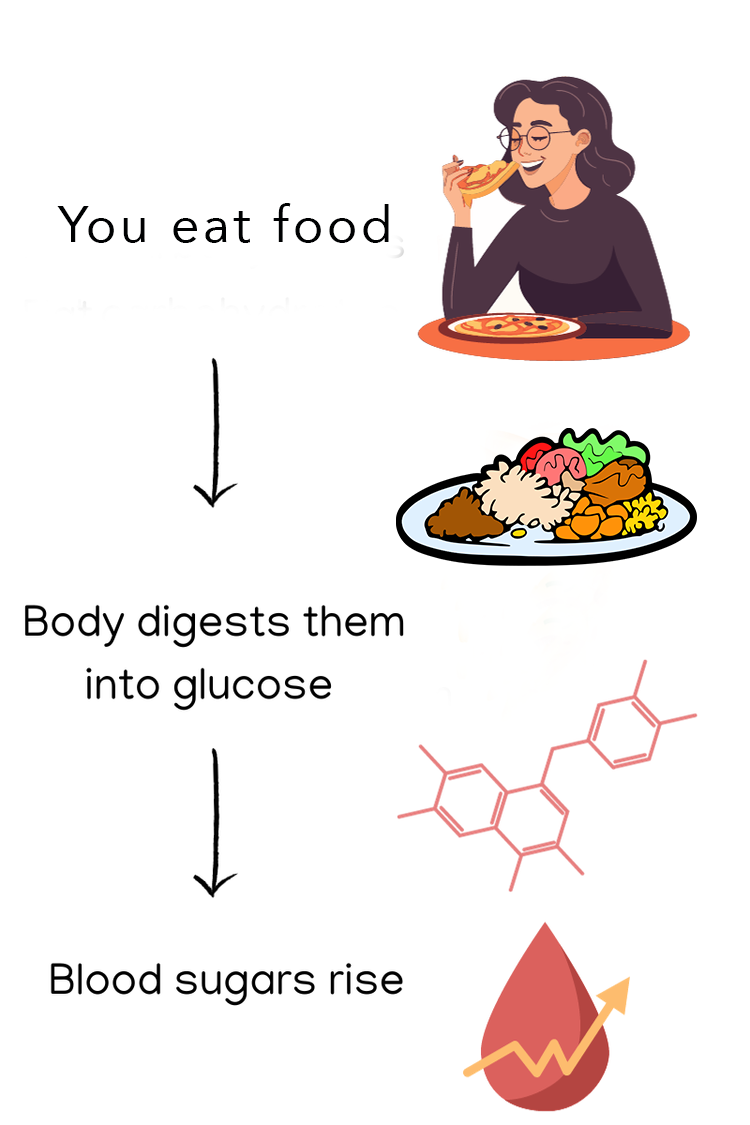What is Glucose
Glucose is the food you eat, broken down into a simple sugar that your body uses for energy. When you eat foods i.e. bread, fruit, rice, or vegetables, your digestive system turns the carbohydrates in those foods into glucose.
This glucose enters your bloodstream, raising your blood sugar levels. In response, your pancreas releases a hormone called insulin, which acts like a key to help your cells absorb glucose and use it for fuel.
Your body relies on glucose to power everything — from your muscles moving to your brain thinking. Keeping glucose levels balanced is essential:
Too much glucose over time can lead to insulin resistance and chronic health issues.
Too little glucose can make you feel weak, shaky, or lightheaded.
What is Insulin
Insulin is a hormone made by the pancreas, a small organ behind your stomach. Its main job is to help regulate your blood sugar (glucose) levels and allow your body to use glucose for energy.
Here’s how it works:
When you eat, your body breaks down carbohydrates into glucose, which enters your bloodstream.
This rise in blood sugar signals your pancreas to release insulin.
When insulin is working properly, blood sugar stays balanced — not too high or too low. But if something disrupts this process (like insulin resistance or insufficient insulin production), it can lead to health issues like diabetes or metabolic dysfunction.
When Blood sugar goes up so does Insulin
What this graph shows that we can see that when our blood sugar goes up - so does our insulin. SO when we know how much glucose there is in our blood we know how much insulin we are producing.
Insulin Sensitivity VS Insulin Resistance
When we spike too high with glucose and insulin, especially from eating lots of sugar or processed carbs, it sets off a chain reaction. If this happens repeatedly, your cells and their receptors become overwhelmed and start ignoring the insulin signal — like a tired worker tuning out constant noise. Over time, these receptors can become damaged, making it harder for glucose to enter the cells.
This is how insulin resistance develops, and unfortunately, so many people unknowingly eat in a way that contributes to it. With damaged receptors, sugar stays stuck in the bloodstream instead of fueling your cells. And what does your body do with all that extra sugar? Well, insulin steps in and says, “I’ll take care of this!” — by storing the excess sugar in your fat cells.
Meanwhile, your cells, starved of the energy they need, start screaming for more food. So, you eat again, causing another insulin surge, and the cycle continues.
Breaking free from this cycle involves restoring insulin sensitivity through balanced nutrition, movement, and mindful eating — so your body can return to using glucose as fuel instead of constantly storing it as fat.


